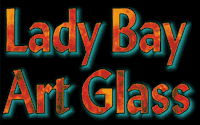 |
|
|||||||
All content is
© Lady Bay Art Glass. Reproduction in whole or part is not permitted.
Whilst we understand that it is possible to copy anything on this site we ask that you only do so for your own immediate viewing and that if you want to use parts of this site for other purposes you should ask our permission first.
Background
When we started Lady Bay Art Glass in 1993 we wanted to be able to offer designs that were thoroughly authentic to the regional style and also in proportion to the size of houses found locally. The Dover Publications (a noted publisher of all sorts of pattern books and the source of many of our stained glass pattern books) title "Treasury of Traditional Stained Glass Designs", is based on original glass window and door patterns found in and around London. This comprehensive pattern book is used by many in the trade as a source for period patterns but unfortunately the designs found within it are very different to those found in our locality.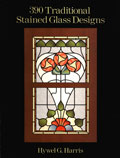
At that time our photographic archive was expanding rapidly, recording local stained glass examples. In what turned out to be the basis for our designs portfolio I started transcribing the most relevant and useful photos into line drawing patterns to be able to show to potential customers. When we had enough drawings they were offered to Dover who published them as "390 Traditional Stained Glass Designs" (Our suggested title had been "English Domestic Stained Glass Patterns 1880-1940").
Our designs portfolio is based around this collection of drawings and consists of designs for door and window panels for houses dating from 1880 through to 1940 in many styles from Victorian Geometric and Floral to Art Nouveau, Edwardian, 1920's &1930's floral and landscape, and Art Deco. Since the publication of the book, the collection of additional material has continued, and the extensive portfolio for door panels is presented in full colour as can be seen in the portfolio section of this site.
The photographic archive provides a further source of material and we can also call on a number of useful stained glass pattern books for inspiration. A significant benefit of the portfolio being in an editable form is that we can provide drawings scaled to the panel size required to show the customer the effect of size and proportion changes. Also we can easily mix and match designs so that a motif can be taken from one design and incorporated into another.
This focus on traditional design means that when required we can use this expertise to create designs to complement existing stained glass panels.
History
There are certain broad design rules that apply to the various styles of stained glass panel. The Victorian geometric style is characterised by the use of single or double borders one of which was usually red handmade glass (always the inner of a double border). The inner part of the panel is divided into rectangles always taller than they are wide, usually of an aspect ratio of 3high:2wide overlaying which are one or more motifs which include geometric and stylised floral elements. More upmarket designs used painted scenes as the main motif. The use of handblown roundels is common. Colours are always impure (for example the yellows are usually slightly green, the greens are usually slightly yellow or grey/blue, other colours are a little grey) probably because of the impurity of the colouring chemicals used in glass making. This is a positive benefit in that whatever the combination of colours they usually go together well. The background glass is often a patchwork of 5 or 6 different pale colours.
Victorian floral designs can be very elaborate but still often use a border to the panels. There is quite a lot of crossover with Art Nouveau designs. Colours are still muted and impure, milky opals and heavy ripple textures probably imported from the USA are sometimes used.
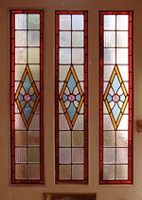 |
 |
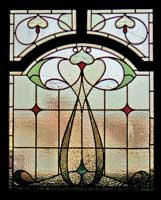 |
| Typical local example of Victorian Geometric. | Typical local example of Victorian Floral. | An example of the Art Nouveau style. |
The Edwardian era introduces a change to domestic architecture in general and the theme of light and simple elegance is echoed in the glass designs. Gone are the red borders and the multicoloured backgrounds to be replaced by clear textured glass to let a lot of light in. The motifs are floral with the stylised tulip and rose shapes common. Colours are similar to those used in Victorian times but less of them. There are some crossover designs that have floral motifs on a clear background but with the classic Victorian red border. It is only around 1908-1910 that the Edwardian style becomes fully established in its own right.
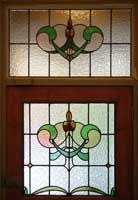 |
 |
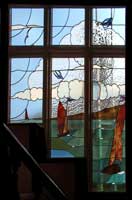 |
| Typical local example of an Edwardian Panel. | Typical 1920's door panels using clear glass texture. | A fine example of 1920's seascape scene. |
After WW1 styles change again but the change is subtle to start with being still based on the Edwardian floral motifs on a clear background. Panels based on the floral tulip and rose motifs are still common but a new style, more geometric, with Art Deco overtones is making an appearance. New ranges of glass with very heavy textures, mostly in clear but also in some colours, are introduced so that panels made in this style use only or mostly clear glass but in a wide variety of textures resulting in a completely new look. Landscape scenes become common in the more well appointed houses, for landing and cloakroom windows, occasionally in this part of the country in front doors. These employ mostly coloured glass, some opalescent and a lot of streaky rolled cathedral glass, using lighthouses, windmills, country cottages, bridges over streams and sailing ships as the themes.
Reproducing the Styles
When we design for a particular position we always take account of the age and style of the property, very often recommending that the owners look at their neighbours houses or we would point them to other areas of similar houses so that they get a feel for what will look right. This is equally important if for example the original front door is missing. When a new door is required this invariably means a custom made one. There was no such thing as a standard door size and the styles were many and varied. A good joiner will be able to copy a surviving example.
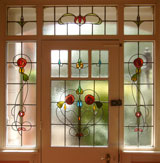 Where a house has any existing stained glass then the design for any new panels has to take account of that style in order for the new to sit happily with the old. Where the new design will be visible at the same time as the old, either by the owners from inside or anyone else from the outside then the design should attempt to echo the layout, motifs and proportions and to some extent the colours of the old panels. The design on the left had its main door panel missing with no photographs of what had been there. There were no similar houses in the locality which have this design so a new panel design had to be created to fit in with the existing panels. Elements from the side panels and the small door panels were used to create a panel layout that fits well with the orignal.
Where a house has any existing stained glass then the design for any new panels has to take account of that style in order for the new to sit happily with the old. Where the new design will be visible at the same time as the old, either by the owners from inside or anyone else from the outside then the design should attempt to echo the layout, motifs and proportions and to some extent the colours of the old panels. The design on the left had its main door panel missing with no photographs of what had been there. There were no similar houses in the locality which have this design so a new panel design had to be created to fit in with the existing panels. Elements from the side panels and the small door panels were used to create a panel layout that fits well with the orignal.
The glass colours and textures used in a panel are important to the authentic look of the panel. There is more information in the Glass section but it should be noted that each period has its own glass types and colours. Modern glass is not always subtle in either texture or colour but there are a considerable number of glass types that work well in period designs. We always ask a commissioning customer to come to the workshop to choose the glass and we are happy to advise on selection.
